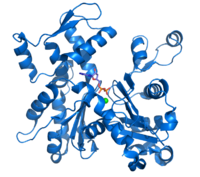
Photo from wikipedia
Physical contact between organelles are widespread, in part to facilitate the shuttling of protein and lipid cargoes for cellular homeostasis. How do protein‐protein and protein‐lipid interactions shape organelle subdomains that… Click to show full abstract
Physical contact between organelles are widespread, in part to facilitate the shuttling of protein and lipid cargoes for cellular homeostasis. How do protein‐protein and protein‐lipid interactions shape organelle subdomains that constitute contact sites? The endoplasmic reticulum (ER) forms extensive contacts with multiple organelles, including lipid droplets (LDs) that are central to cellular fat storage and mobilization. Here, we focus on ER‐LD contacts that are highlighted by the conserved protein seipin, which promotes LD biogenesis and expansion. Seipin is enriched in ER tubules that form cage‐like structures around a subset of LDs. Such enrichment is strongly dependent on polyunsaturated and cyclopropane fatty acids. Based on these findings, we speculate on molecular events that lead to the formation of seipin‐positive peri‐LD cages in which protein movement is restricted. We hypothesize that asymmetric distribution of specific phospholipids distinguishes cage membrane tubules from the bulk ER.
Journal Title: BioEssays
Year Published: 2020
Link to full text (if available)
Share on Social Media: Sign Up to like & get
recommendations!